#Tanuki Creative Studios
Text

Why did I made fan art dedicated to Jitsu Squad? Because the developers behind this hidden gem Tanuki Creative Studios paid me a visit: to experience a mind blowing, jaw dropping, eye popping, off the wall, well crafted, heart pounding beat-em-up with a killer soundtrack, stellar animation, intuitive controls, unique playstyle and many guest appearances.
And the best part? It kicks ass! ;)
4 notes
·
View notes
Text

Promotional artwork for the 2022 title by Tanuki Creative Studio & ININ Games.
Jitsu Squad
Follow Randomised Gaming on Tumblr, for video game, art, reviews, features, videos and more. You can also find us on YouTube, Twitch & Twitter for even more gaming & video content! Buy us a tea on Ko-fi
#game key provided to randomised gaming#Jitsu Squad#Xbox One#Arcade#Scrolling Beat'em Up#Nintendo Switch#PlayStation 4#PlayStation 5#Steam#ININ Games#Tanuki Creative Studio
2 notes
·
View notes
Text
Game Review: "Jitsu Squad" (PlayStation, Nintendo Switch, Steam PC)
Game Review: "Jitsu Squad" (PlayStation, Nintendo Switch, Steam PC) | #gaming #NintendoSwitch #PlayStation #Steam #PCgaming
There was clearly a lot of love that went into the making of Jitsu Squad – love for the Teenage Mutant Ninja Turtles arcade game, that is. Aside from the obvious inspirations and comparisons to TMNT, there are a plethora of other video game and pop-culture references throughout Jitsu Squad.*
Naturally, some light spoilers will follow.
Much like the aforementioned TMNT arcade game, Jitsu…
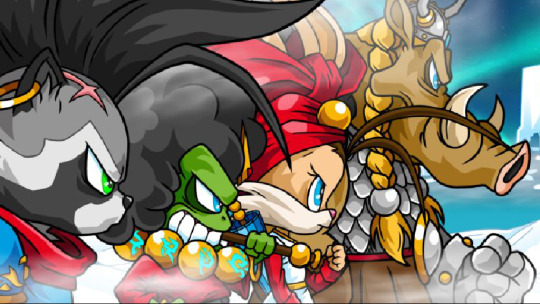
View On WordPress
2 notes
·
View notes
Video
youtube
Some like it hot, but not this hot in Jitsu Squad
#youtube#jitsu squad#tanuki creative studio#beat'em up#gaming#Jitsu Squad PS5#PlayStation 5#Nintendo Switch#PC Gaming#Beast Gamer Kuma
0 notes
Text

Il beat 'em up cartoonesco Jitsu Squad è in arrivo su tutte le console il 9 dicembre
Il picchiaduro a scorrimento sviluppato da Tanuki Creative Studio sarà in vendita in digitale su PlayStation Store, Nintendo eShop e Microsoft Store al prezzo di 29,99 €.
Info:--> https://www.gonagaiworld.com/il-beat-em-up-cartoonesco-jitsu-squad-e-in-arrivo-su-tutte-le-console-il-9-dicembre/?feed_id=322864&_unique_id=63887749a4a73
#ININGames #NintendoSwitch #PlayStation4 #TanukiCreativeStudio #XboxSeriesX|S
2 notes
·
View notes
Text
The SML Podcast - Episode 827: Advent Sinking
Download Episode 827 --
We join this episode in progress because they were already talking when I joined on discord. Who needs intros?
The show kicks off with the whole crew on the show! That's right, Tim Ekkebus, Chris Taylor, Brooke Poole, Pernell Vaughan, Jacob Garner, and Aki are all on hand to discuss the things we collect, including model kits that show up months early (or late!), Star Wars toys, video games, and then we move on to talk about Advent Calendars and now we need an SML Advent Calendar with a pancake every day except the last day is the syrup and butter. Man I have great ideas. Plus reviews!
0:00 - Intro/Chatter
16:05 - Milk inside a bag of milk inside a bag of milk and Milk outside a bag of milk outside a bag of milk - Nikita Kryukov, Forever Entertainment (Brooke)
27:22 - Tanuki Sunset - Rewind Games, Digerati (Tim & Jacob)
45:00 - The Legend of Tianding - Creative Games Computer Graphics Corporation, Neon Doctrine (Pernell & Jacob)
1:00:14 - Silver Nornir - WorldWideSoftware, KEMCO (Chris)
1:11:41 - CounterAttack - Relative Games (Pernell & Jacob)
1:22:02 - Alterity Experience - Onitron Studio, Dolores Entertainment (Chris)
1:30:33 - Nitro Kid - Wildboy Studios, tinyBuild (Pernell)
1:39:51 - My Big Sister: Remastered - Stranga Games, GrabTheGames (Chris)
The show ends with some GROOVY Earthworm Jim music from The OneUps!
1:46:29 - The OneUps - Andy Asteroids (Earthworm Jim)
https://twitter.com/nkt_krkv
https://forever-entertainment.com/
https://twitter.com/rewindgamesca
https://www.digerati.games/
https://www.cgcg.games/
https://www.neondoctrine.com/
https://www.wwsft.com/
https://www.kemco-games.com/
http://relativesoftwareltd.com/
https://twitter.com/OnitronStudio
http://doloresentertainment.com/
https://www.wildboystudios.com/
https://www.tinybuild.com/
https://strangagames.com/
https://www.grabthegames.com/
https://theoneups.bandcamp.com/
https://www.troggostudio.com/product/20
https://itunes.apple.com/us/podcast/the-sml-podcast/id826998112
https://open.spotify.com/show/6KQpzHeLsoyVy6Ln2ebNwK
https://twitter.com/theSMLpodcast/
https://www.facebook.com/theSMLpodcast/
ALL REVIEWED GAMES HAVE BEEN PROVIDED FOR FREE FOR THE PURPOSE OF ANY COVERAGE ON THE SHOW
#Xbox #Switch #PS5
0 notes
Text
[Gaming News] ‘Jitsu Squad’ - All out fighting to create a brawler not to miss!
Awesome news from @ININ_Games
‘Jitsu Squad’ - All out fighting to create a brawler not to miss! physical and a digital release later this year.
The wildest squad in town is back – Jitsu Squad is getting ready for console release
Lightning-fast fighting game Jitsu Squad dashes onto consoles in Q4 2022.
Get ready for the wildest fighting game on the block! ININ Games is excited to announce that they will bring Tanuki Creative Studio’s fast-paced 2D beat ‘em up adventure Jitsu Squad to Nintendo Switch, PlayStation 4 (PS4) and PlayStation…

View On WordPress
0 notes
Note
🛼🌹 any of our ships
Sorry it took a while! But here is my response!
🛼: Amity x Henry
"Ehhh.. Henry. You know what I changed my mind. I don't actually need to roller skate for my comic!" Amity smiled nervously as she was being led to the rink by her partner.
Henry chuckled at her, seeing his usually confident girlfriend fluster at the idea of rollerskating.
“C’mon, Amity. You were the one who wanted to come here, after all.”
"Well yeah.." Amity started. "But not to actually skate, just to, ya know. People watch! Ye-yeah that's it!"
Henry smiled at Amity, doing his best to try and calm her nerves some.
"Amity. It's okay to be nervous. If it helps, i can hold you hand the whole time if you're worried about falling."
"That.. Would help a lot actually." Amity blushed. "Thanks , Henry."
"No problem, Amity."
🌹:Tyler X Dakota
"Here, Tyler. I got these for you." Dakota smiled sheepishly as he brought the bouquet of flowers into his boyfriend's studio.
"Oh. Dakota, thank you." Tyler said. "But why the sudden flowers?"
Dakota shrugged with a blush. "Oh, I don't know. I just saw these flowers and thought of you!" The centaur shone a bright smile at the tanuki, putting the flowers in a vase.
"Besides, I was thinking that maybe they could help bring some inspiration. I remember you saying you were having a bit of a creative block lately."
Tyler was quiet for a moment. "Actually, I think those flowers were just the inspiration I needed!" Tyler got up from the spot were he was sitting to his desk to start sketching some designs. Yet, before he did so. He gave Dakota a quick peck on the cheek.
"Thank you, Dakota."
3 notes
·
View notes
Text
Jitsu Squad finanziamento record su Kickstarter
Jitsu Squad finanziamento record su Kickstarter
Kickstarter Page – Demo Download
Strictly Limited Games è lieta di annunciare la collaborazione con Tanuki Creative Studio, uno sviluppatore con sede nei Paesi Bassi, sul loro prossimo titolo Jitsu Squad. I giocatori possono partecipare su Kickstarter per assicurarsi una copia digitale o fisica del gioco per Nintendo Switch, PlayStation 4, PC e Xbox One. Indipendentemente dalla campagna…
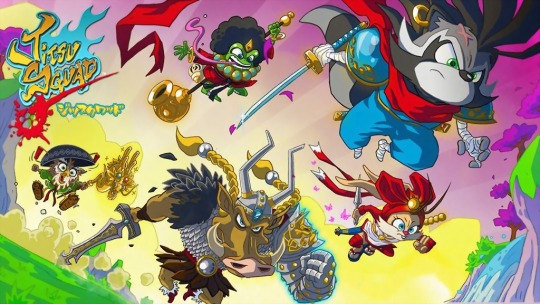
View On WordPress
2 notes
·
View notes
Photo

I can say my life has been crazy and full of adrenaline and adventures so far! I never stopped working hard and I always wanted to give a proper shape to all my dreams! If you can dream it, you can do it, right? 😄⠀ ⠀ Aside from my Professional Cosplayer career, I find myself in 2020 training in Pro Wrestling and modelling for wonderful videogames such as Jitsu Squad™! 🎮⚡️⠀ ⠀ Jitsu Squad is a wonderful videogame developed by Tanuki Creative Studio and I’m really excited and honored to be part of it. I will give you more infos on March 3rd so you better stay tuned!🌟⠀ ⠀ #leonchiro #prowrestling #JitsuSquad #TanukiCreativeStudio (at Rome, Italy) https://www.instagram.com/p/B9IcRbHJwk6/?igshid=w8tf492rxmye
47 notes
·
View notes
Text
Ranking Every Studio Ghibli Movie

Studio Ghibli's contribution to anime (and animation in general) cannot be understated. Founded by directors Hayao Miyazaki and Isao Takahata, and producer Toshio Suzuki, the studio has produced many of Japan's most hallowed films, movies that are both critically acclaimed and monsters at the box office. In 1996, Disney partnered with Studio Ghibli to bring their movies to North America, developing a new audience that has since come to age; now, Ghibli is as much a part of American childhood as Pixar and Dreamworks releases.
On Anime Pop Heart and @beneaththetangles, we are commemorating the studio with Ghibli Month all September long! I’m kicking things off by ranking Ghibli's twenty-one releases, plus Nausicaa of the Valley of the Wind, which is often honorarily included among the studio's slate, ranked from first to worst (including alternate viewpoints on a couple of the selections).

22. Tales from Earthsea
Miyazaki famously quarreled with his son, Goro, over the latter's ability to direct Tales from Earthsea, and indeeed, the final product feels like the result of a young man who was in over his head. The movie deserves its ignominious reputation, as it is inconsistent, poorly staged, and often terrible. It's a shame, too, for there are some strong elements to the film and enormous potential, with the outlines of an epic tale and compelling characters in Sparrowhawk and Cob (who are wonderfully dubbed by Timothy Dalton and Willem Dafoe, respectively)—it just never comes quite together and totally unravels at the end, resulting in the only bad film in Studio Ghibli's outstanding run.
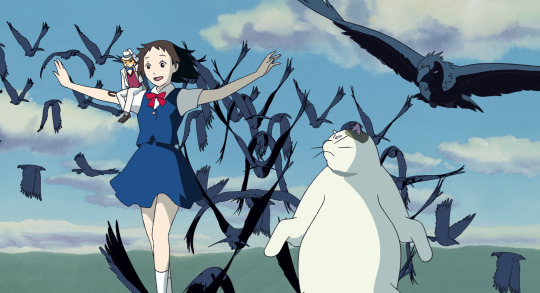
21. The Cat Returns
Most Studio Ghibli films are family features, made for children. However, they still capture the imagination of youth and adults as well. The Cat Returns, the only "sequel" in Ghibli's film catalog, doesn't do the same however. It is purely for kids, and aside from flourishes here and there that speak of fantasy adventures and feature whimsical characters, fails to engage viewers of a certain age—maybe anyone older than about twelve. A neat companion piece to Whisper of the Heart, it's worth watching, showing to your children, and then giving away to parents who need better-than-average entertainment to busy their children.
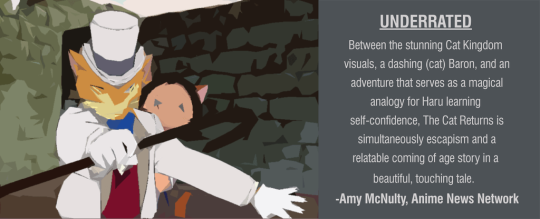
20. Ocean Waves
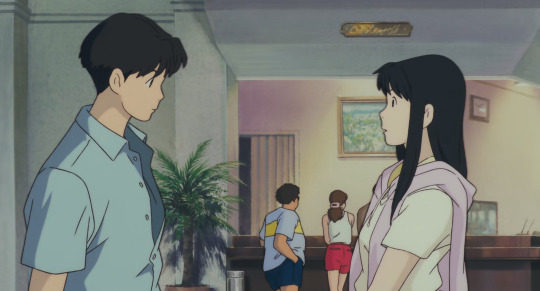
At one time, Ocean Waves was considered a black eye in Ghibli's filmography, an overpriced television movie that wasn't all that good. In retrospect, the intial judgments were only partially right. Ocean Waves is very much a TV movie, melodramatic and small in scale. The animation, too, is sometimes shoddy, but more often than not it's far better than it has the right to be. Ocean Waves is lovingly made, and the characters are almost frustratingly sincere—and oh so early 90s. While on the lowest tier of the Ghibli scale, Ocean Waves is far better than a simple curiosity.

19. Arrietty
Like Poppy Hill before it, there's nothing terrifically wrong with Arrietty—it just lacks the magic of the great Studio Ghibli films, making it rather forgettable. It's also sometimes dull. While beautiful colors, a foreshadowing of the spectacular animation to come of Yonebayashi in Mary and the Witch's Flower, shine through in the film, and some of the action sequences are highly engaging, our hearts are never fully in it. Maybe that's because we lack a loving connection to many of the characters, particularly to the pensive Sho. A nice watch, but one that's lacking.
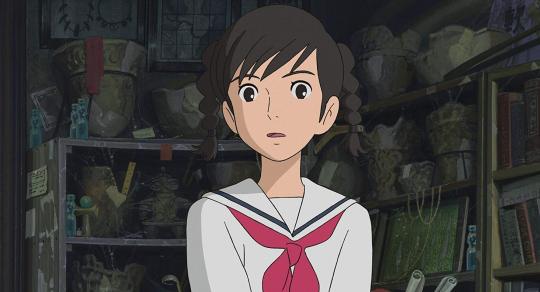
18. From Up on Poppy Hill
Much maligned for our lowest ranked movie, Goro Miyazaki returned from that entry with a stronger film, one that functions as an ode to historic preservation while presenting one of the studio's most lovely relationships—that is, until it gets a bit tricky, unfortunately begining to enter a zone unusual for Studio Ghibli, if standard fare for other anime. But that's a relatively minor issue in what's a perfectly lovely film that does well in evoking nostalgia in a movie that reminisces about the past and a Yokohama that no longer exists. Not every emotional moment hits as it should, but enough do to make the film Ghibli's best "date night" entry.

17. Pom Poko
Often criticized for being too over-bearing in its ecological message, Pom Poko's main issue instead is that it's meant to a collection of stories that to flow into one another, based on one group of tanukis' fight against urban development, but the movie doesn't feel cohesive, partly because there is no central protagonist. We only get to know each main tanuki so much, and none feel central to the tale—any could step in and play the necessary roles. Still, Pom Poko is unreservedly charming and often hilarious. It's also a peek into Japanese culture that we often don't get, a look at a country transforming in landscape and in values.

16. Ponyo
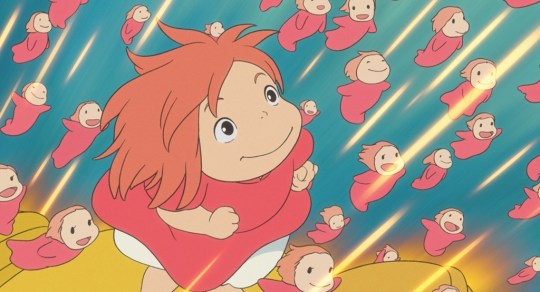
Why is Ponyo the low point of Miyazaki's output, the only film of his that doesn't attain the level of classic? It is wonderfully animated, bursting with energy and featuring a story that is never disingenuous and a heroine that is funny, cute, and breathtaking even. However, the film proved that Miyazaki was on a downward trajectory after Spirited Away. Repetition seen in Howl's Moving Castle was on full display in Ponyo, a new movie that too often feels like a rehash, featuring characters that other than the title heroine, fail to connect, and a story that is muddled and often just strange. Ponyo is a fun film and a better one after repeated viewings—the problem is that such defenses do not have to be made for any of Miyazaki's other works.
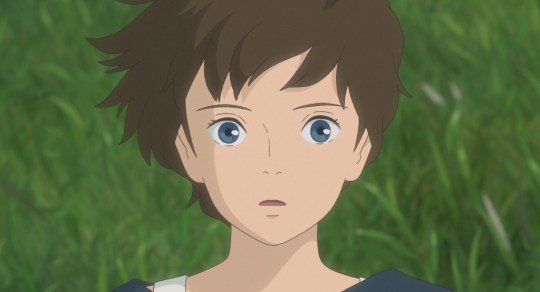
15. When Marnie Was There
The last feature film from Studio Ghibli to date is both quietly personal and a surprising risk. When Marnie Was There is the studio's first true mystery tale, and has a tone that's slightly haunting. The lead characters, also, are unusual for Ghibli—neither Anna nor Marnie are as embraceable as most of the heroines from Ghibli's past, but that seems be purposeful. What they demonstrate to us is not as much of "who we can be" but "who we are" and even so, how we can overcome. The creative energy of past Ghibli films is missing, but the replacement here by a surprising intimate tone in a modern setting is welcomed.

14. The Tale of the Princess Kaguya
While this notoriously expensive film flopped at the box office, The Tale of the Princess Kaguya was well-received by critics, and for good reason. Adapting a famed folk tale, the film is animated in style befitting its origins, creating the sense that the viewer has fallen into a some traditional Japanese painting. But the movie is not as pastel as its colors indicate—the storytelling is bold. It doesn't sit in the past, instead feeling remarkably current in the fable of a princess imprisoned by seemingly everyone and everything, without ever feeling worn or heavy-handed. Mystical and fantastical elements are both woven into the foundation of the story and come alive in key moments, keeping the film compelling (for the most part) throughout its two hour+ run time.
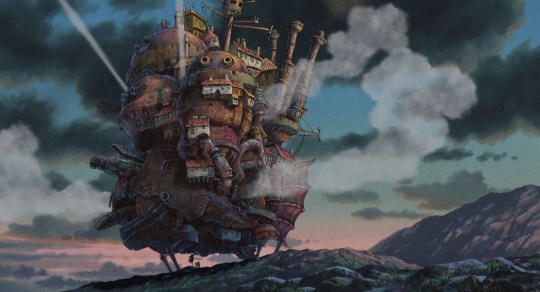
13. Howl's Moving Castle
An underrated aspect of Studio Ghibli's brilliance is in how they often adapt already-beloved works. Adapted by the master, Howl's Moving Castle, based on the novel by Diana Wynne Jones, is gorgeously animated and bold in both design and character—Howl and Calcifer, particularly, are memorable (and give strong emotional weight to the tale). While it suffers in comparison to its predecessor, Spirited Away, by being a little unwieldy, it remains a classic and an example of how well Miyazaki can bring themes and plot points across subtly (think of the flashback of Howl) in a movie that's otherwise fierce and larger than life.

12. The Wind Rises
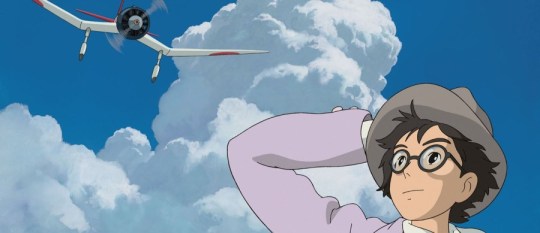
From conception, The Wind Rises was a challenging film—how do you tell the story of the man who designed a fighter essential to Japan's WWI efforts, and show him as a patriot and dreamer without excluding the crimes of the nation, or making a film that goes against Miyazaki's anti-war values? It's difficult to say if he succeeds, but the film itself is beautifully crafted. The supporting characters here are less important than in other works, so it's vital that the audience admires Jiro Horikoshi, and we do—his character and positivity make him easy to root for, and dream sequences in the film both flesh out his thought process and keep us captivated. Once believed to be Miyazaki's last film, if it had been, The Wind Rises would have been worthy of that designation.

11. My Neighbors the Yamadas
The oddball in Ghibli's filmography, My Neighbors the Yamadas is presented through half-a-dozen or more short stories in the style of comic strips come to life, with animation that matches. The magic in the film is that the Yamadas are as over-the-top as the movie's aesthetic is, yet maintain an authentic feel. Think of some of the most popular family sitcoms of the 1980s and 1990s, but with an addition those shows could not feature—fantastical sequences that break in without warning and bind the ties of family further. We may not want to live like the clumsy Yamadas, but the heart of the family will make you consider whether they're the ones who really have it all together.
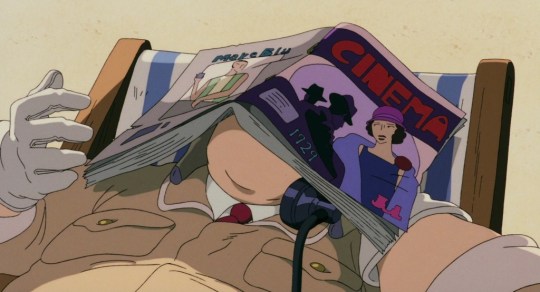
10. Porco Rosso
Studio Ghibli films share animation styles and themes, but one can never say they lack in variety when it comes to story. The tale of Porco Rosso is of an ace pilot cursed into living as a pig—but not to worry! He is still adored by women as he flies fantastic missions while running from fascists, pirates, and fame-seeking assassins. Porco is gruff and unattractive, but both he and the tale are sweet, as what's already a compelling story of WWI aces and dogfights is buffeted by grief, romance, and two strong heroines of very different types and roles. Perhaps the film with the largest range of opinion among the Miyazaki classics, Porco Rosso is nonetheless fantastic, and require viewing if you haven't watched it already.
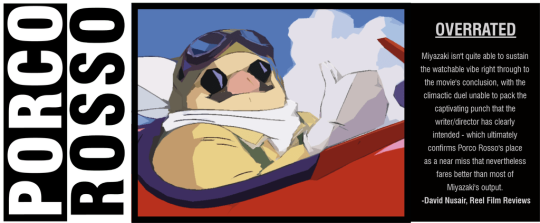
9. Whisper of the Heart

Ghibli's most unabashedly romantic film is one of its most formulaic, but still among its best. The debut film by Yoshifumi Kondō, Miyazaki and Takahata's proposed successor before he died just a few years after the movie's premiere, is at once encouraging while also refusing to shy away from the melancholy experienced by children—and adults, too—when one doesn't seem to have what it takes to become great. In joy and sadness, Whisper of the Heart lets the kids at the center of the film be kids. They are at times stubborn, silly, and immature, and by treating them that way, the movie never drifts into something banal (with the possible exception of the famously abrupt ending)—it's a lovely lesson in growing up and meeting challenges, and a personal favorite.
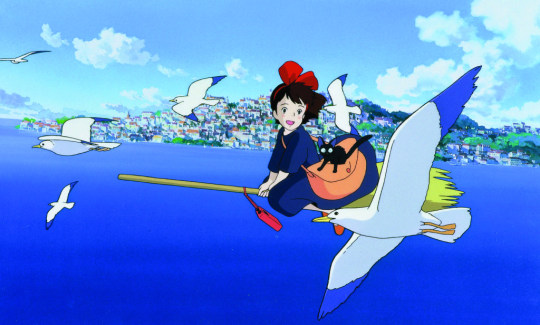
8. Kiki's Delivery Service
The charm of Kiki's Delivery Service is two-fold—in the setting, a northern European-style town that is alive, forcing the events of the story through its residents, cozy cafes, and early 20th-century transportion, and in Kiki's journey itself. Her community's tradition of sending of young witches to live by themselves at the age of thirteen sets the story in motion, and Miyazaki captures the spirit of a girl that age perfectly—in all its confusion, energy, enthusiasm, and difficulty. Kiki is not a subtle character, but her growth is. When she takes to the air for the finale, Kiki isn't experienced enough to know if she can save the day—and so we cheer when she realizes what the rest of us already know, what we've all experienced ourselves, that it takes time and failure to mold us into becoming the hero.

7. Castle in the Sky

Miyazaki created classic film after classic film for decades, in a streak that started with Lupin III and ended, I'd argue, with Howl's Moving Castle. Often forgotten among the wonders is Castle in the Sky, a steampunk entry that is a joyous adventure, akin to Treasure Island but developed for an audience of both boys and girls. Sumptuous cloudscapes fill the screen, as do colorful characters with meaty roles, including a group favored by Miyazaki—pirates (in this movie, air pirates led by Dola, an older female). Reflective of Miyazaki's ability to master genres, Castle in the Sky again crosses fantasy and sci-fi in perfect proportions, underscoring an uplifting tale with an apocalyptic story line.

6. Nausicaa of the Valley of the Wind
Unofficially part of of Ghibli's canon, the success of Nausicaa, based on Miyazaki's own manga and exploring the ecological, anti-war, and feminist themes for which the studio's future films would be noted, launched Studio Ghibli. Nausicaa herself remains one of the studio's most iconic and compelling heroines, a physically powerful and feminine hero who must grow into adulthood very quickly while putting aside deep flaws to offer salvation to her people and land. The beautiful landscapes speaks to the epic story, better fleshed out in the manga, while reminding us that Ghibli films are giants not only in animation, but in fantasy and sci-fi realms as well.
5. Only Yesterday
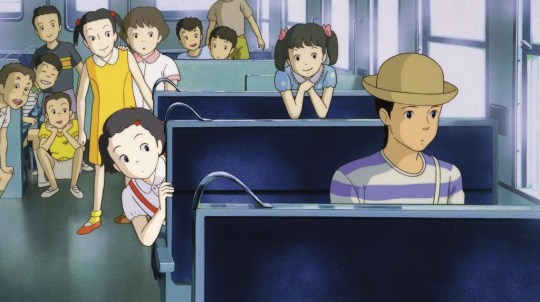
How do you create an animated film about a twenty-something woman that waxes nostalgia while on a trip to the countryside, and at the same time make it entertaining and accessible? It's not an easy task, but Only Yesterday accomplishes it fully. Taeko, the protagonist, explains, "I didn't intend for ten-year-old me to come on this trip, but somehow, once she showed up, she wouldn't leave me alone." We experience her nostalgia for and complicated feelings about the past through a family that's genuinely flawed, while experiencing her visit to relatives in the countryside in the present, a trip that is subtly life-altering, one that pushes her to consider who she is and who she wants to be. Oh, and the film also features one of anime's most wonderful endings, set to a cover of a now-classic love song.

4. Grave of the Fireflies
It's a testament to Miyazaki's stature that the first three Ghibli films on the list are all directed by him, and also to the supreme talent of the other directors that their films rise above some of his other tremendous work. Directed by Studio Ghibli co-founder, the legendary Isao Takahata, Grave of the Fireflies is the most painful and emotional movie in the canon; it is also one of the greatest war movies ever made, using animation to deftly explore the how war victimizes children. Opening and closing shots, both of which express the uncaring nature of bystanders (and by extension, the world) toward children cause us to wonder what we really feel about the world's most vulnerable population.
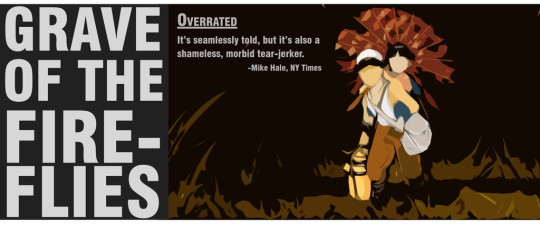
3. My Neighbor Totoro
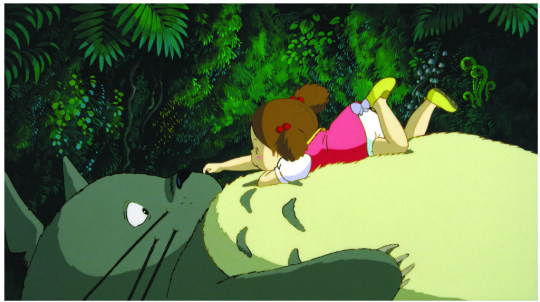
It's often said that nothing really happens in My Neighbor Totoro—but that's part of the magic of the film. A child's movie in all ways, including in the action, which revolves around a sick mother, a move to a new house, and a lost child, the film finds its center in a magical being that never says a word (Totoro only growls), and about whom many theories abound. If Totoro is a figment of Satsuki and Mei's imaginations, he is then similar to Winnie the Pooh, a necessary presence in the lives of a child character (two of them, sisters, in this case) who is growing up in a difficult situation, not to adulthood, but to the next step in the journey of life.
2. Spirited Away

Miyazaki has retired and unretired several times—when did so following Princess Mononoke, he returned with what is often considered his magnum opus, Spirited Away. At once deeply Japanese and completely accessible, the movie takes viewers on one of the most remarkable visual journeys ever put to film, a feast that never relents through its entire run time. Perhaps underrated is Miyazaki's decision to move the action away from the bathhouse for much of the final act, a quiet last leg that is key to Chihiro's journey, as well as for many of Spirited Away's supporting characters. Absolutely deserving of all love and acclaim.
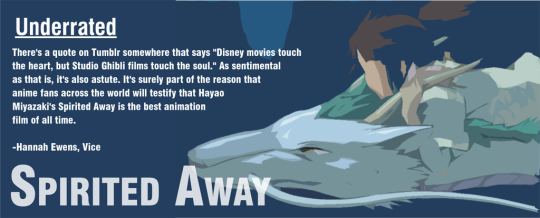
1. Princess Mononoke
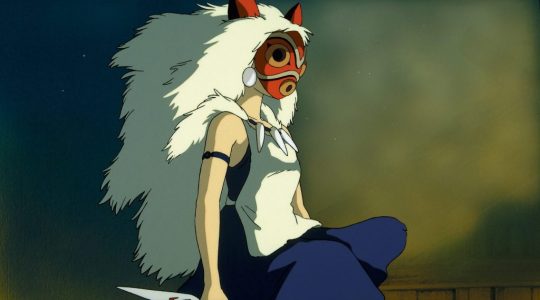
Studio Ghibli's finest film is also perhaps its most surprising. Visceral, violent, and conflicting, Princess Mononoke is no easy tale to absorb. There is no "good guy," not in the traditional sense, as Miyazaki explores hist favored ecological theme but through the lens of humanity struggling to survive in a world where they are just surpassing nature, the beast gods and goddesses who had previously ruled. It is an epic in the vein of films from decades before with vibrant and complex characters, ground-breaking animation, and an English voice track that is second to none. The studio's most intricate work, Princess Mononoke requires multiple viewings to fully appreciate.

--
All Studio Ghibli movies are available for sale, including many in special collectible editions. We encourage you to go check them out!
155 notes
·
View notes
Text
Pompoko
To talk about Pompoko ("La guerra de los mapaches de la era Pompoko" in Spanish), the Japanese animated film produced by Studio Ghibli, you must first know about its creator, Isao Takahata.
Japanese director, producer and screenwriter who, in the past, directed mythical series that marked several generations such as "Arupusu no Shōjo Haiji", "Haha o Tazunete Sanzenri" or "Akage no an". Together with Hayao Miyazaki, he founded Studio Ghibli and, the first two films of Takahata within the factory, are authentic masterpieces, considered essential feature films in the history of cinema. The heartbreaking "Hotaru no Haka" (1988) and the melancholic "Omohide Poro Poro" (1991) were his letter of introduction, with which he demonstrated that he was facing a new creative cycle, with a more mature approach and a desire to experiment with animation.
Pompoko was the logical evolution in this search for both artistic and narrative experimentation, a change for Takahata, who had only done dramas before. The film was released in Japan on July 16 (1994), making it the studio's ninth feature film. It managed to become number one in the Japanese box office collecting 2.63 trillion yen in its first week, far exceeding the previous production of Takahata. Such was the recognition among the public and critics that it was the first Japanese animated film selected to represent Japan at the Oscars in the category of Best Foreign Language Film of the Year 1994. Although it did not obtain the necessary support to enter Among the five nominations, it was awarded in 1995 with the Crystal Award for Best Feature Film at the Annecy International Animated Film Festival, France.
Its international distribution took ten years to come to light although its delay was not as late as other productions of Isao Takahata's Studio Ghibli. In the United States, the film was released directly to DVD in August 2005 within the Disney catalogue. In Latin America, the film was released directly on DVD in January 2011 in Mexico, thanks to the Zima Entertainment distribution.
The film is set in a typical Japanese folkloric setting. The protagonists are tanuki or raccoon dogs typical of Japan. According to popular tradition, the tanuki can transform into humans or other creatures just by wishing. However, they are also known as lazy and naive beings. "The key to transformation is to subject the mind and body to extreme discipline. This is easy for a fox, but raccoons are unconcerned about everything by nature ...", explains the narrator of the film.
The film shows the social reality of the economic growth of Japan in the 1960s. In 1966, in the city of Tama, located on the outskirts of Tokyo, it is the setting that Takahata chose to narrate his ironic and particular elegy towards those Tanukis who they 'fought' for a lost cause. The film shows the rapid economic growth of the area, at the cost of a real environmental massacre, by destroying farms, forests, mountains and villas to build buildings, neighbourhoods, roads and that the human being ends up completely invading the area.
When a family of these animals discovers that men are destroying the forest where they live to build new urbanization. Because of this, after many years (and centuries) of rivalries between clans, they decide to sign peace to confront a common enemy: the human being, whom they declare war, determined to re-establish the balance of nature and not lose their home. They prepare to fight them using all their power and skills in a war, never seen before. But since the intentions of the raccoons are known, it is intuited what will be the result of this conflict. Hence, Takahata makes an interesting combination of comedy and tragedy.
That idle nature is used to create humorous sequences, with which to play with the artistic style of the film. But with comedy as an invitation letter, you can already perceive the adult spirit of a film that is not intended for children, as it happened in all his filmography within Studio Ghibli. Not only for humorous situations but the characters themselves, since in Japanese mythology male tanukis can use their bellies as a drum and their testicles can be stretched to such a point that they can be used as a weapon, like a parachute, to float, fly or attack. Something that, effectively, the Japanese public will understand, while the one who is foreign to this folklore will baffle him. Therein lies the main virtue of both 'Pompoko' and Takahata's work within Ghibli, he made his films with a strong Japanese spirit, thinking about the audience in his country.
Despite the many references of Japanese folklore, Pompoko has a universal ecological message, in that fight to preserve his home, the forest, the meadow, the mountains. Takahata creates a sharp counterpoint in which the human being seeks the constant expansion of civilization without conversing with nature itself, breaking the balance of sustainable development. It is a powerful environmental claim, showing the direct and indirect consequences of uncontrollable development, finally looking face to face at the viewer to invite them to seek a form of sustainable growth and remembering that the protection of nature, like the fight against climate change, is essential as a society, as human actions affect flora and fauna, which are the ones who pay the consequences of such irresponsibility. A sublime film that is one of the most important legacies of Isao Takahata.
-Hoshi
3 notes
·
View notes
Text
Beastly Brawler “Jitsu Squad” Coming to PlayStation, Nintendo Switch in December
Beastly Brawler “Jitsu Squad” Coming to PlayStation, Nintendo Switch in December | #gaming #PlayStation #NintendoSwitch #ps5 #Nintendo
Gesundheit.
ININ Games has announced that the retro-inspired brawler Jitsu Squad will be available on 9 December for PS4, PS5 and Nintendo Switch. A digital-only release for Xbox is planned for a later date.
Developed by Tanuki Creative Studio, Jitsu Squad is a 2D beat ‘em up featuring unique character designs, a hand-drawn 2D visual aesthetic, online and local co-op for up to four players,…

View On WordPress
1 note
·
View note
Photo

Pom Poko (1994, Japan)
As one of the co-founders of Studio Ghibli, the late Isao Takahata famously did not know how to animate. Whether because or in spite of that, he became the studio’s philosopher-poet – posing mature questions of ethics and humanity to audiences that no one else working in animated film could accomplish. Takahata’s third film for Ghibli, Pom Poko, breaks the fantasy-reality polarity he shared with Hayao Miyazaki (who just finished 1992′s Porco Rosso and was underway with 1997′s Princess Mononoke).
Yet this is a fantasy striking for its allegorical richness, even if the quasi-documentary, voiceover narration-heavy approach to the story makes this one of Takahata’s weaker films – a weaker film judged within lofty standards, however. The film revolves around a group of tanuki (Japanese raccoon dogs), some of whom can shapeshift, as they combat the ever-encroaching urban and suburban sprawl to their forests. Their tactics are initially successful, but – as consistent with Japanese mythology – their indiscipline, prideful factionalism, and inability to effectively communicate among those growing factions doom the lifestyle they hold dear. Which other director of animated film, past or present, could express those aspects through tanuki, letting them become reflections of the vast tapestry of human behavior? I can think of no one else but Takahata.
It is the late 1960s in the Tama Hills in Kanagawa Prefecture, just southwest of Tokyo. Japan’s post-War economic boom has precipitated into a skyrocketing demand for housing, and the Tama Hills have been designated for significant residential and commercial development. By the early 1990s, New Tama is threatening the tanuki’s forest and resources not provided by human litter and trash are declining. Led by matriarch Oroku, the militaristic Gonta (Takahata’s loving parody of Miyazaki’s dictatorial attitude to work at Ghibli), the wise and wizened elder Seizaemon, and a young up-and-comer named Shoukichi, the tanuki resist the humans by committing sabotage at the construction sites. Some of the leaders advocate for simply scaring or intimidating humans (recall that some tanuki can shapeshift); others are more interested in killing or maiming as many humans as possible. No matter which tactic is adopted, the developers send new and more employees – forcing the tanuki to send a few their own to seek out the advice of master shapeshifters from across Japan.
For older viewers who are creeped out or will not see this film because of its depiction of tanuki testicles, if pure disgust is the only reason why you are discounting Pom Poko from your movie-watching options, you need to be more open-minded in what makes quality cinema. In Japanese art, tanuki have always been shown with their testicles, and often using them in creative ways (as a drum, a backpack, etc.). This is always handled with a wink by Takahata, with no self-seriousness whenever tanuki testicles are being used in transformations.
Pom Poko has been described as an ecological fable within the canon of Ghibli’s pro-environmentalist films like Nausicaä of the Valley of the Wind (1984), Only Yesterday (1991), and Princess Mononoke. Consumerism and unrestrained capitalism are fundamental to the environmental destruction that occurs, disallowing humans and tanuki from living in harmony as they used to before Japan’s reintroduction to the international theater. But these themes are not fundamental to Pom Poko. The film’s human characters are caricatures, somewhat removed from ever being fully understood by the tanuki. What the tanuki partake in – the ideological divisions that corrode their culture despite a clearly-defined common goal – is the true focus of the film, not the supposed sweeping declarations of how humanity should learn how to coexist with nature. With a story by Miyazaki and the screenplay by Takahata, there are also references to Japanese folklore and culture that will escape almost all Western viewers (including this one), but these never detract from the feelings of cooperation and selflessness, betrayal and disillusionment that define the tanuki struggle against the human developers. Just be prepared to research certain cultural elements that made no sense afterwards.
The tanuki are riven by internal differences that leads to an unorganized response to the human developers’ progress. Central to the quandary is the balance between intimidation, scaring the humans, and violence. Tanuki elders hold mass meetings with the entire populace – due to their species’ tendency to party hard after even the most inconsequential success, their audience seem too distracted to take successive debates and wisdom-laced speeches seriously. There is too little effort to listen to the tanuki leaders and, eventually, master shapeshifters and learn about their disagreements. Such disagreements are embodied in the belligerent Gonta and the peaceful Seizaemon and Oroku. Gonta believes only spectacular violence can alter their apparent fates. He launches unauthorized offensives with the most disgruntled tanuki to obliterate infrastructure and send construction workers to their ghastly ends. Later, Gonta even attempts a failed coup against Seizaemon and Oroku, believing their methodical approach to the situation is leading to their imminent destruction. The violence accomplishes little, as the humans do not understand the root of this ecoterrorism.
Seizaemon and Oroku are more interested in understanding human culture than Gonta, urging transformation-capable tanuki to integrate themselves into among humanity to learn as much as possible. But the transforming tanuki scouts largely observe humanity from a distance, rarely inquiring to humans about the nature of their culture – its history, its contemporary demands, and why its envisioned future is what it is. The first meaningful conversation with a human is initiated by Shoukichi at a moment far too late to salvage the tanuki’s society. When everything else has failed, a fantastical display without words of what was the symbiotic relationship between humans and tanuki will save the latter from extinction. As Seizaemon and Oroku become obsessed in understanding humanity without communicating with humans, they lose sight of the transformations within their own ranks. These two are blindsided by too many things. They fail to anticipate Gonta’s treachery despite obvious signs of his combustible impatience, fail to intuit the widespread inattentiveness of their mass meetings, or – in the most underdeveloped subplot of the film that Takahata should have paid more attention to – fail to detect the fatalism of the non-transforming tanuki that sees them join a suicidal Buddhist dancing cult that results in a massive waste of life.
Pom Poko is a film defined by poor leadership. Their internal discord is preventable and surmountable as the tanuki leaders decide to ignore the welfare of those who cannot transform or those who do not adhere to their adopted strategies. Poor communication is rampant. The rigidity of their beliefs hastens their downfall. Contrary to the expectations of the leadership, the introduction of the shapeshifting masters only exacerbates their dilemma – the masters are basing their approach on ancient anecdotes and an assumption that talking with humans need not be considered. Like in Grave of the Fireflies, pride might be the tragic flaw of the protagonists. But where pride in Grave of the Fireflies leads to the deaths of a pair of siblings, pride is projected onto saving a collective in Pom Poko. When pride presides over a group through its leaders, disaster is destiny.
This is not to say Pom Poko is only a dour piece examining effective leadership. The film is also a broad comedy not above fart jokes, slapstick, and situational humor. One of the funniest, enrapturing moments is thanks to animation directors Megumi Kagawa and Shinji Ôtsuka (both of whom have served in various roles on almost all of Ghibli’s films). Tragicomedy is complicated to execute, and Takahata just about manages the balance here – Pom Poko’s tragedy never interferes with its comedy and its comedy usually does not cheapen the tragedy. Vacillating between the two tones will be jarring for those without grounding in live-action classic Japanese cinema – a bittersweet celebration in the film’s final moments is followed by a closing, ascending shot reminiscent to the final moments of Grave of the Fireflies. There, the tanuki have been forced to assimilate to human culture. Displacement, not just by physical means, abounds. If it is not obvious yet, Pom Poko (the highest-grossing domestic film at the Japanese box office in 1994) should not be considered a gateway Studio Ghibli film and plays better in tandem with live-action Japanese movies.
Behind the scenes, a special relationship that helped Studio Ghibli further cement its place in Japanese popular culture was just beginning. Nippon TV (NTV; a major broadcast network in Japan) chairman Seiichirô Ujiie began to help produce Studio Ghibli films beginning with the studio’s 1993 television special Ocean Waves (a testing ground for Ghibli’s younger staffers; it was released elsewhere as a theatrical film). Pom Poko was the first feature film he co-produced (alongside Ghibli co-founder Toshio Suzuki and Ritsuo Isobe) for the studio, beginning NTV’s long-running association with Studio Ghibli – in Japan, NTV is the exclusive broadcaster of all Ghibli films and is usually the first network to provide breaking news of Studio Ghibli activities. Ujiie was involved in the production and financing of almost every Ghibli film released after Pom Poko – his passing in 2011 made producing new Ghibli feature films much more difficult. Ujiie professed that he was a Takahata fan, once proclaiming that he would fund any of the director’s projects, even if they lost money (such as 2013′s The Tale of the Princess Kaguya, in which Ujiie received posthumous credit).
Task any other animation director with Pom Poko, and they would probably deliver a more juvenile, less considered film. Of all Takahata’s films, Pom Poko may be the one work that could only have existed through animation. It is his least intimate Ghibli movie as it adapts an epic war story within a faux documentary structure. On the surface, it seems like Takahata is taking fewer risks than usual because of animation’s necessity here. Look closer and, in the same tradition of Watership Down (1978... though not nearly as serious as this movie), Takahata is sharing ideas seldom depicted in animated or live-action cinema. Pom Poko is not his finest outing nor is he at his most visually inventive. But to compare this with his other films is to compare artworks operating at a mesmerically high standard.
My rating: 8/10
^ Based on my personal imdb rating. My interpretation of that ratings system can be found here.
#Pom Poko#Isao Takahata#Toshio Suzuki#Studio Ghibli#Hayao Miyazaki#Ritsuo Isobe#Seiichiro Ujiie#Megumi Kagawa#Shinji Otsuka#My Movie Odyssey
3 notes
·
View notes
Text
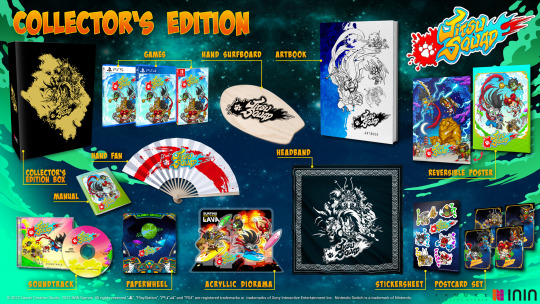
Inin Games apre i preorder per le edizioni fisiche per console del brawler "animalesco" Jitsu Squad
Il titolo sviluppato da Tanuki Creative Studio sarà distribuito in edizione fisica per Nintendo Switch, PlayStation 4 e PlayStation 5 quest'inverno.
Info:--> https://www.gonagaiworld.com/inin-games-apre-i-preorder-per-le-edizioni-fisiche-per-console-del-brawler-animalesco-jitsu-squad/?feed_id=303842&_unique_id=6335a72182f9f
#ININGames #JitsuSquad #NintendoSwitch #PlayStation4 #PlayStation5 #TanukiCreativeStudio
0 notes
Link
The realms of Hayao Miyazaki have given the world some of the most endearing, enchanting, and eccentric characters ever animated. While most of them do spring forth from the director's own creative spirit, many of them come from a place of semi-reality as they can be found in real-world folklore.
RELATED: 10 Ghibli Animated Creatures That Are Too Cute To Take Seriously
While Miyazaki has often kept secret the inspiration for his stories, those versed in the genre can easily spot the folklore influence in his work. From Soot Sprites to river dragons, Miyazaki's characters have been spirited away from fantasy and fairytales across the world into his fantastic feats of animation.
10 Ponyo - The Little Mermaid
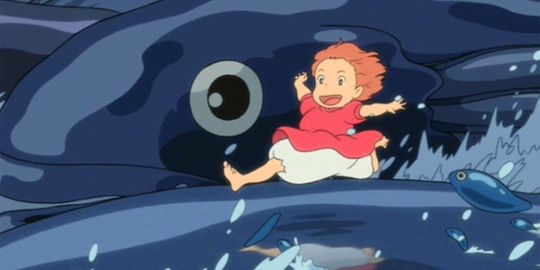
Though Miyazaki is often ambiguous about his inspirations, one source he made openly plain was the connections between Ponyo and Hans Christian Andersen's The Little Mermaid. Despite her bright red hair, Ponyo takes more from the original source than her Disneyfied counterpart.
Although Miyazaki's interpretation is still very kid-friendly, elements like Ponyo becoming human after winning someone's love, her shapeshifting, and her spiritual connections to the water are all based around Andersen's mythos.
9 Fujimoto - Captain Nemo

Not a mythical creature, but the water wizard Fujimoto shares several remarkable similarities with another man obsessed with the ocean. Fujimoto's mystical practices and potions resemble a certain aquatic scientist created by Jules Verne, none other than Captain Nemo himself.
RELATED: 10 Jules Verne Movies You Should Watch If You Love Adventure
With his love of the ocean paired with his eccentric nature and disdain for humanity, Ponyo's father is one Nautilus away from being a direct copy of Nemo. It might be more of an observation than purposeful influence, but the similarities are there.
8 Catbus and Totoro - Cheshire Cat

Similar to Fujimoto and Nemo, a direct visual influence on both Totoro and the Catbus has to be Lewis Caroll's Cheshire Cat of Wonderland fame. While My Neighbor Totoro does share an element or two with Caroll's classic novel, those big smiles and feline faces make the influence obvious between the characters.
Although Miyazaki's characters aren't as verbose or mischievous as their literary counterparts, the image of the grinning characters in an enchanted forest setting is definitely blatant with its influence.
7 Soot Sprites - Brownies

Soot Sprites are an original Miyazaki creation, there's no dispute on that one. However, their nature sounds remarkably similar to a creature of western folklore. Brownies are fairy-like creatures with dirty appearances that perform tasks around the house—that is until they're seen, of course.
RELATED: Studio Ghibli: 15 Things You Never Knew About My Neighbor Totoro
In My Neighbor Totoro, they're flighty creatures who vanish if someone spots them. In Spirited Away, they load the boiler with coal in the bathhouse one at a time. While their outward appearance might differ, they certainly behave like Brownies to a T.
6 Tanuki - Tanuki

Now for something more blatantly obvious, the tanuki clan from Pom Poko. Like their film counterparts, tanuki are mischievous forest spirits from Japanese folklore. Resembling raccoon-like creatures, these friendly little furballs are near-perfectly represented in Miyazaki's vision.
Like their mythological versions, Miyazaki's tanuki meet all the tropes from the lore. They shapeshift, they're comical, and they even perform feats using their "pouches." Kudos to the director for being true to form.
5 No Face - Hungry Ghost/Gaki

Like the Soot Sprites, No Face is an original creation by Miyazaki but bears a strong behavioral resemblance to a creature from folklore. This time, however, No Face's inspiration comes from a creature that literally means "hungry ghost."
RELATED: 10 Studio Ghibli Foods You Can Actually Try In Real Life
Gaki are ghosts in Japanese mythology who died of starvation forced to blindly consume through all eternity. Like the ghosts, No Face is a spectral being who, when corrupted by the bathhouse, becomes a greedy and constantly consuming creature. He certainly has that part nailed down, doesn't he?
4 Yubaba/Zeniba - Baba Yaga

While many might be quick to compare the two witches of Spirited Away to Oni Baba of Japanese folklore, they more accurately take from the Russian Baba Yaga in more ways than one. Through these two characters, Miyazaki embodies different versions of the legend.
Though they lack the famous chicken-legged house, Yubaba and her sister Zeniba behave and resemble a more contemporary Baba Yaga. With one being cruel and greedy and the other being mysterious but benevolent, they both represent the dichotomy of the character in Russian fairytales.
3 The Wolves - Okami

Princess Mononoke takes a great deal from traditional Japanese legend, but perhaps the most visually memorable are the wolves that raise and aid San in her adventure. These giant white canines are clear references to the famous Japanese Okami prominently featured in ancient folklore.
RELATED: 10 Ghibli Animation Creatures That Are Almost Too Creepy To Look At
Being raised by wolves is a common mythological trope, but, when the wolves are powerful beings and divine messengers, one tends to take notice, especially when they take up most of the film's artwork.
2 Kamanji - Tsuchigumo

Kamanji is a curious case, seeing is how he only takes partial inspiration from his creature of influence. With his multiple appendages and black attire, the boiler man of Spirited Away is an obvious humanoid spider, but, specifically, he takes from Tsuchigmo.
These strange chimera creatures were said to be driven out of ancient Japan and supposedly were mythical equivalents of tunneling tarantulas. If they were truly driven out of their place of origin, does that make Kamanji one of a kind?
1 Haku - Eastern Dragon

Who could forget the mysterious and beautiful Haku? Obviously an Eastern dragon, but there's more to Haku than just his serpentine form. In fact, he takes influence from both Japanese and Chinese versions of the creatures.
Eastern dragons are often benevolent creatures associated with rain or bodies of water. In Japanese mythology, rivers are often a common association with dragons and their dominions. Basically, where there's water, there are dragons.
NEXT: 10 Best Ghibli Villains
10 Studio Ghibli Creatures Inspired by Actual Folklore from https://ift.tt/3sm5BTN
0 notes